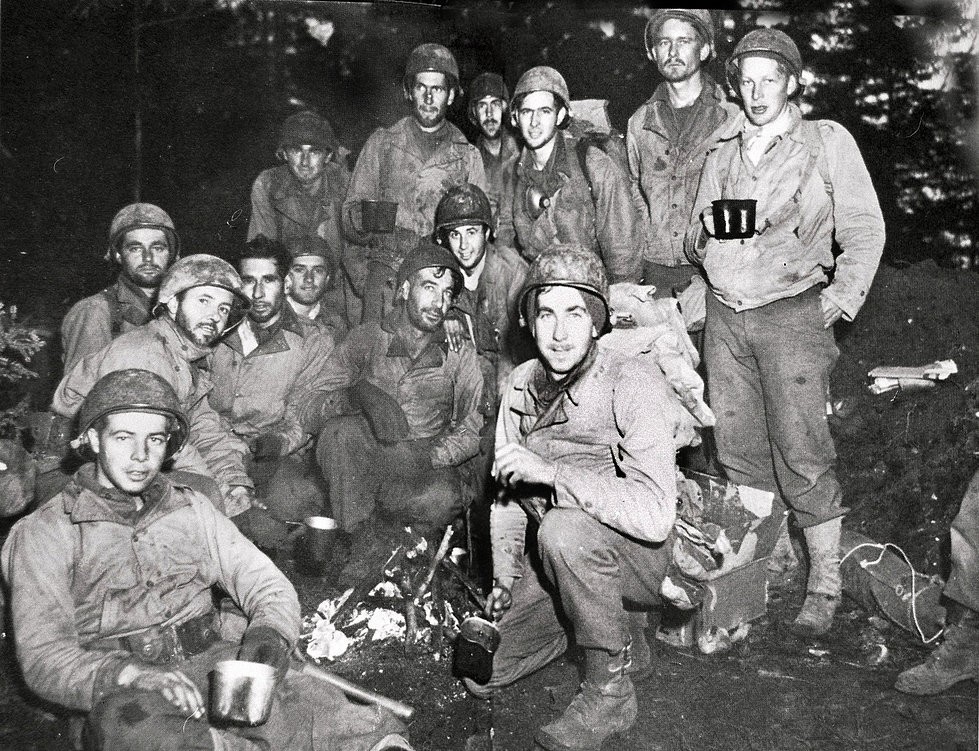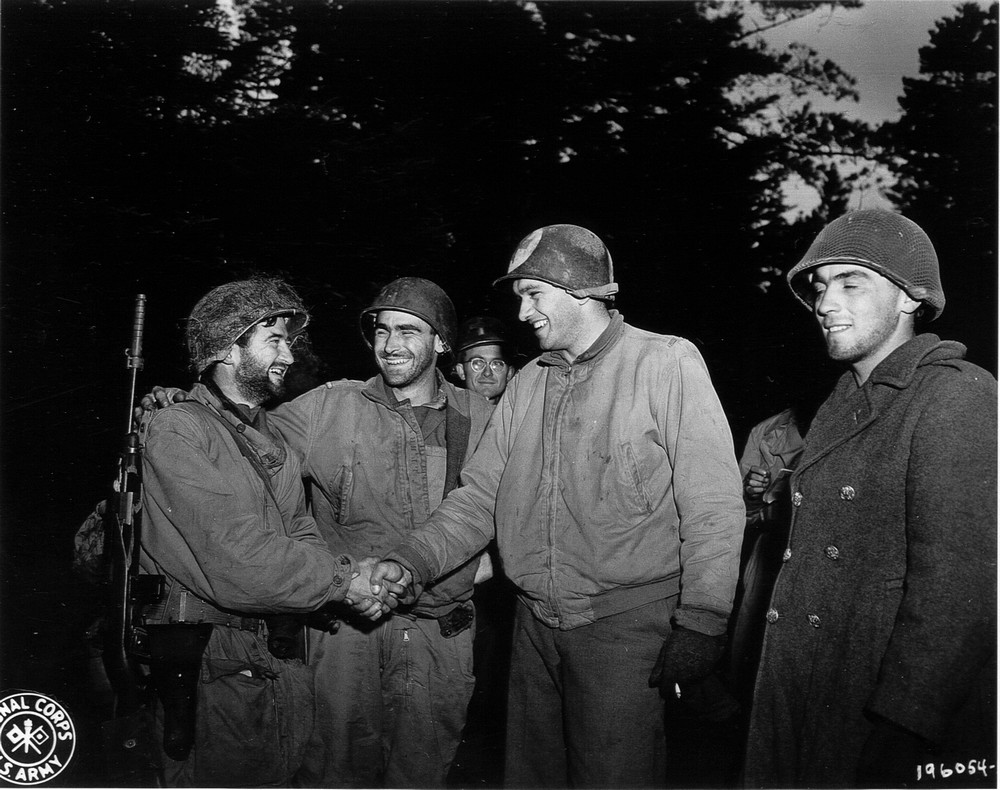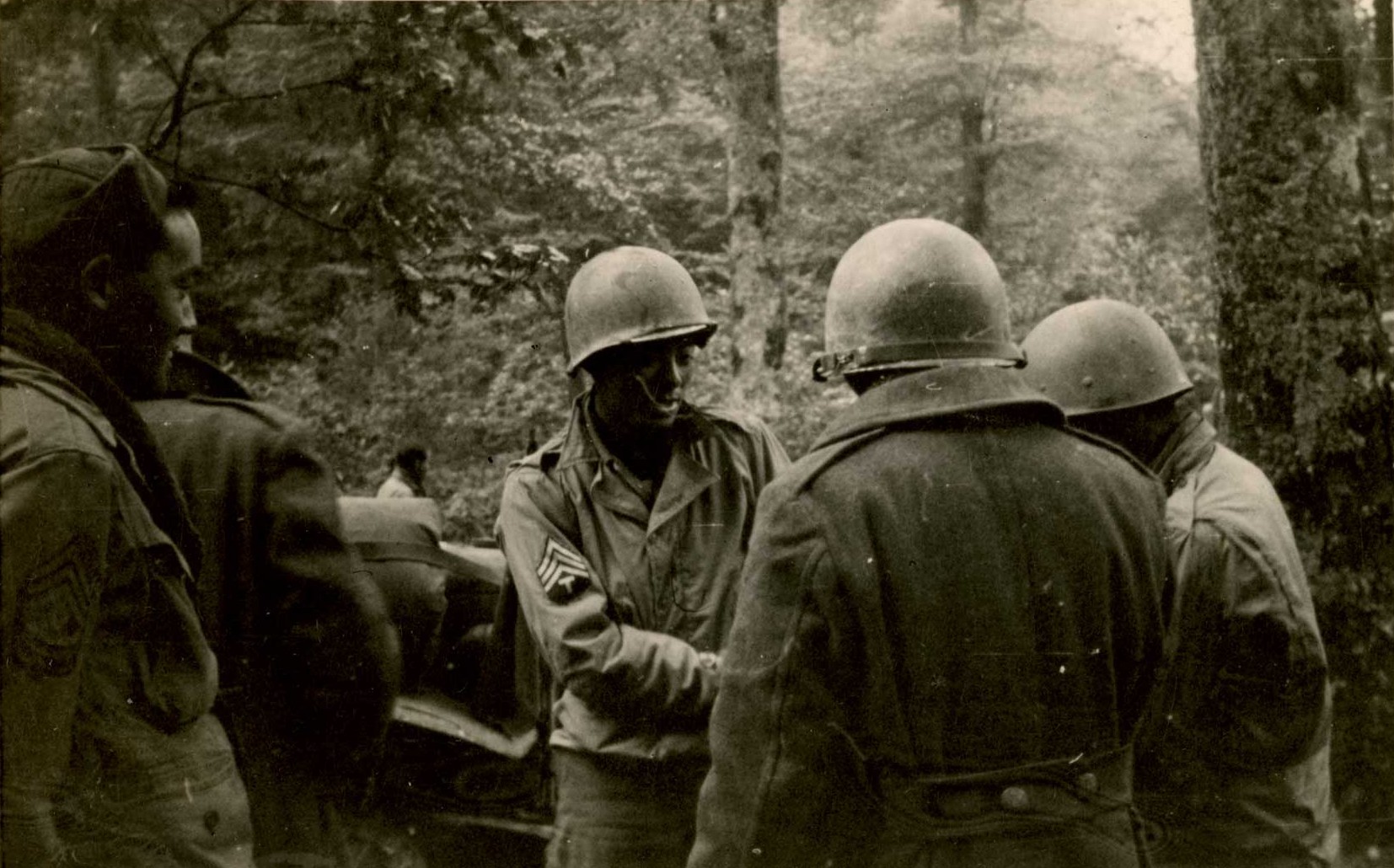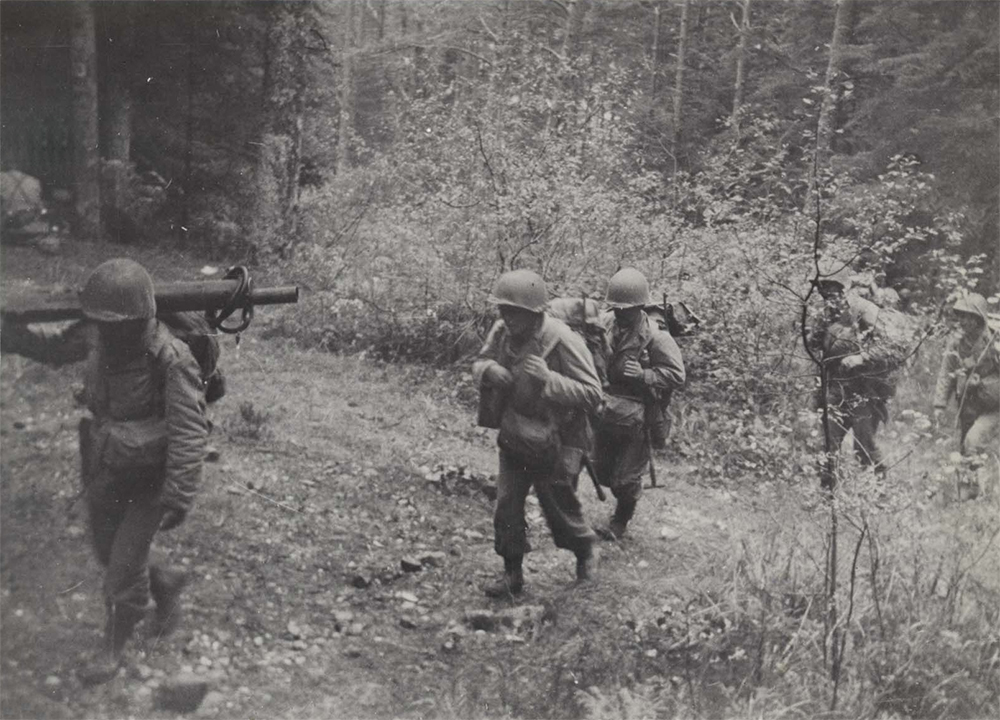The Lost Battalion


Jamais nous n’aurions cru être si heureux de voir des Japs
We never thought we’d be this happy to see Jap faces
La bataille pour laquelle le 442nd Regimental Combat Team est si connu est le sauvetage de plus de 200 hommes du 1st Battalion, 141st Infantry Regiment de la 36th Infantry Regiment ayant été coupé du reste de leur régiment dans la Forêt Domaniale de Champ dans le Bois de la Bourse à proximité de Biffontaine.
Le 24 octobre, le 1/141st IR oblique au sud-est en bordure d’une chaîne très boisée qui part de Biffontaine et se termine au-dessus de Vanémont. Le bataillon rencontre peu de résistance et progresse très rapidement. Il se trouve près de son objectif en milieu d’après-midi. Mais dans la journée, une contre-attaque ennemie coupe les arrières du bataillon et se retrouve isolé et encerclé au Trappin des Saules à plus de 3km de ses lignes. Bombardés de toute part le Bataillon perd 50 hommes au cours de cette attaque.
Le lendemain, Les 2nd et 3rd Battalions du 141st IR, appuyés par une compagnie de chars, engagent une puissante contre-attaque pour tenter une percée vers le bataillon isolé. Ils sont repoussés à chaque offensive par un ennemi bien retranché dans des positions fortifiées. Voué à une disparition certaine, le 1/141st devient le « Bataillon Perdu. »
Plus de 270 hommes du 1/141st sont bloqués sur cette crête. Les tentatives des deux autres bataillons du régiment pour les sauver qui durent depuis 3 jours ont toutes échoués et les vivres et munitions commencent à manquer. Dahlquist décide finalement d’envoyer le 442nd pour tenter de les sauver.
En début d’après-midi du 27 octobre, les Nisei font mouvement vers l’étroite crête où sont encerclés les T-Patchers. Sur le flanc droit, le 100th Battalion chasse les allemands à travers un ravin sur la prochaine colline. Mais ceci se révèle être un piège, les allemands écrase les Nisei avec un violent barrage d’artillerie durant une heure. Ce bombardement tue et blesse mais les vétérans de Monte Cassino tient fermement leur position.
Au centre, sur l’étroite crête, la K Company se heurte à une série de trois systèmes défensifs fortement ancrées. Dans la soirée, les 100th et 3rd Bn. ont avancés de quelques centaines de mètres mais ont fait des dizaines de prisonniers. Cette même nuit, le commandant du 2/442nd, le Lt. Col. James Hanley, se met à la tête des E et F Companies pour encercler des troupes ennemis près d’une colline à proximité ; Hill 617.
Pendant ce temps, la G Company du 2nd Battalion se propage dans la forêt pour faire croire qu’un bataillon entier marche en direction des emplacements ennemis. A l’aube, elle attaque frontalement les positions ennemies tandis que les E et F Co. attaquent Hill 617 depuis l’ouest et prennent d’assaut la colline jusqu’à son sommet prenant par surprise ses défenseurs qui se rendent en grand nombre.
Le 29 octobre, la situation du Bataillon Perdu est désespérée. Isolé depuis 6 jours, les hommes ont repoussés 5 assauts ennemis. Les morts et les blessés montent en flèche, mais ils ne peuvent évacuer les corps. Ils se mettent à rationné leurs maigres provisions et se risquent aux tirs de snipers pour chercher de l’eau.
Les grands arbres et les pentes abruptes rendent souvent impossible l’ajustement des tirs d’artillerie. L’extrême précision du 522nd FAB frappe les allemands sans toucher les positions aux hommes du bataillon perdu ou bien les Nisei.
Le 29 octobre, après 5 jours de combats sans avoir beaucoup progresser contre les positions ennemies retranchées, les I et K Companies s’exposent sur une étroite crête où se trouve une pente sur leur gauche et droite et n’ont d’autre choix que d’aller au centre et de lancer une charge à la baïonnette.
Le ravitaillement
Avec le bataillon coupé des lignes, il est dans l’impossibilité de le ravitaillé que ce soit sur terre ou dans les airs… Sauf pour les pilotes de P-47 du 405th Fighter Squadron du 371st Fighter Group. L’unité connaît la situation désespérée du bataillon au sol et son commandant, le Lt. Col. John W. Leonard est volontaire pour ravitaillé le bataillon perdu. Le premier essai pour ravitaillé le 1/141st est effectué le 27 octobre sous un temps affreux. Huit avions transportant chacun deux containers remplis de munitions, nourritures, fournitures médicales et des batteries de radio sont sensés être largués à basse altitude sur la position supposé des T-Patchers. Mais à cause du manque de visibilité, les pilotes doivent revenir au-dessus des nuages et c’est à ce moment-là que 1st Lt. Robert A. Booth perd le contrôle de son appareil et s’écrase sur un flanc de colline.
Deux ravitaillements sont effectués le 28 octobre mené par le Maj. Leonard. Leonard qui est touché par la DCA américaine mais arrive à s’éjecter de son avion et atterrit dans un arbre. Une autre mission a lieux ce jour mais les avions sont cette fois-ci accueillit par la DCA allemande et malheureusement pour eux, les containers atterrissent en territoire ennemi. La quatrième et dernière mission de la journée fait atterrir le ravitaillement près du sommet de la colline.
Incertains d’avoir envoyé assez de provision, les commandants au sol mettent au point une nouvelle opération de ravitaillement. Une centaine d’obus de 105 et de 155mm sont vidés pour être rempli de ‘D’ bars, de la sulfadiazine et des pastilles de décontamination d’eau. Les obus spéciaux sont envoyés juste après la dernière mission de 16h40.
Le General Ralph D. Royce, commandant de la Provisional First Tactical Air Force reçoit un message des radios du Lost Battalion utilisant les batteries que le 405th a précédemment largué « Remerciez nos potes de l’Air Corps, On mange pour la première fois depuis trois jours ! »
Deux autres missions de ravitaillement fait par les P47 auront lieux le 29 octobre.
Le dernier jour
Les 275 survivants parmi les 600 hommes du 1st Battalion partis de Belmont, s’apprêtent à subir l’assaut final des Allemands. En effet ceux-ci sentant l’approche du 442nd veulent anéantir ce qu’il reste du bataillon perdu.
Finalement, le 30 octobre, après 6 jours de combats désespéré, le 442nd passe à travers les défenses ennemies jusqu’au bataillon perdu. Avec seulement 8 hommes restant, la K Company est la première à voir un visage du bataillon perdu, mais tout le Combat Team avait contribué à son sauvetage. Des observateurs avancés du 522nd avaient combattu avec l’infanterie, les membres de l’Antitank Company avaient bravé le feu ennemi en servant de brancardier. Les commis, cuisiniers et les gars du génie du 232nd Combat Engineer Company s’étaient également joint au combat. De nombreux infirmiers avaient bravé le feu ennemi et sauvé d’innombrables vies. Plus de 25 blessés de la K Company furent soignés par le T/5 James Okubo. Okubo fut décoré de la Silver Star, et en 2000, sa décoration fut changer en Medal of Honor.
Le 442nd s’était battu pendant 6 jours et avait sauvé 211 hommes. Une trentaine d’entre eux furent tués et beaucoup d’autres blessés.
A la fin du siège, les hommes du bataillon perdu et leurs sauveteurs échangèrent d’heureuse célébration. Le 442nd offrit leurs provisions à ces hommes qui ces derniers leurs exprimèrent leur profonde gratitude. Mais ceci fut de courte durée.

The Lost Battalion Front line infantrymen of the lost battalion, 141st Infantry Regiment relax around a camp fire after being rescued by 442nd RCT in France. October 31, 1944.
Le 442nd avait enduré 16 jours de combat non-stop. Ce fut la pire campagne que le 100/442nd ai jamais connu. Après avoir perdu tant d’amis et d’officiers, les soldats devaient être relevés, comme ceux du 1/141st l’avaient été. Mais au lieu de cela, Dahlquist ordonna aux hommes de continuer à pousser jusqu’à ce que la forêt soit nettoyée. Ainsi, les Nisei durent se battre pendant encore 9 jours.
Le 8 novembre, lorsque le 442nd est finalement relevé, les morts et les blessés sont à ce moment-là plus nombreux que les vivants. La K Company qui avait commencé la campagne avec 186 hommes se retrouve avec 17 d’entre eux. Quant à elle, la I Company avait commencé avec 185 hommes, il n’en reste plus que 8.
Pour le 442nd, la campagne des Vosges avait duré un peu plus d’un mois de combat presque non-stop. Ceci comprenait la libération de Bruyères et Biffontaine, le sauvetage du bataillon perdu et neuf jours de plus à chasser les allemands dans la forêt. Les pertes totales du 442nd étaient de 160 hommes tués et plus de 1200 blessés.

The new CP for Fox Company, 2nd Battalion 442nd Regimental Combat Team that had just been built for them by an engineer unit. The dugout was constructed in the woods just outside St. Die, France and the photo was taken during the 442nd’s relief in place on November 13, 1944.
Le 12 novembre, Dahlquist fit une cérémonie en reconnaissance du 442nd. Vu le petit nombre d’homme présent, il aurait réprimandé le Lt. Col. Virgil Miller, commandant du régiment : « Vous avez désobéi à mes ordres. Je vous ai dit que je voulais avoir tout le régiment. » Il le regarda dans les yeux et répondit : « Général, tout le monde est là. Les autres sont soit mort, soit à l’hôpital. »
Pour l’armée américaine, le sauvetage du Lost Battalion reste l’un des 10 plus hauts faits d’armes de son histoire. Pour beaucoup, les questions restent sans réponse à propos de la campagne à ce jour. Quelles étaient les motivations de Dahlquist pour envoyer le 141st au-delà de ses lignes de soutien et sans protection arrière ? Pour appeler le 442nd à la rescousse ? Pour les faire pousser d’avantage après que le sauvetage ait été terminé ?
Mais à ce moment-là, les Nisei ne s’étaient pas posé de questions. Ils avaient juste accompli leur devoir en tant que soldat américain.
The battle for which the 442nd Regimental Combat Team is perhaps best known is the rescue of more than 200 men of the 141st Infantry Regiment, 1st Battalion, who were cut off from the rest of their regiment in the Vosges Mountains near Biffontaine.
On october 24, the 1/141st go to the southeast edge of a wooded chain from Biffontaine and ends above Vanémont. The battalion met little resistance and progresses very quickly. It is near its goal by mid-afternoon. But in the day, an enemy attack cut the battalion rear and it is isolated and surrounded in Trappin des Saules over 3km of its lines. Bombarded on all sides, the battalion lost 50 men during the attack.
The next day, the 2nd and 3rd Battalions of the 141st IR, supported by a tank company, committed a powerful attack to attempt a breakthrough towards the isolated battalion. They are repelled by every attack by a well-entrenched enemy in fortified positions. Doomed to certain death, the 1/141st became the « Lost Battalion. »
More than 270 men of the 1/141st are blocked on this ridge. The attempts of the other two battalions of the regiment to save the unit for three days have all failed and food and ammunition running out. Dahlquist finally decided to send the 442nd to try to save them.
In early afternoon of 27 October, the Nisei headed towards the narrow ridge that circled the T-Patchers. On the right flank, the 100th Battalion hunting German through a ravine on the next hill. But this turns out to be a trap, the Germans crushed the Nisei with a violent artillery barrage for one hour. This bombardment kills and injures but the veterans of Monte Cassino firmly holds its position.
In the center, on the narrow ridge, the K Company faces a series of three deeply rooted defensive systems. In the evening, the 100th and 3rd Bn. have advanced several hundred meters but make dozens of prisoners. That same night, the commander of the 2 / 442nd, Lt. Col. James Hanley, starts at the head of E and F Companies to encircle enemy troops near a nearby hill; Hill 617.
Meanwhile, the G Company of the 2nd Battalion spreads in the forest to believe to the that a whole battalion march towards the enemy locations. At dawn, it frontally attack the enemy positions while E and F Co. attacking Hill 617 from the west and stormed the hill to the summit taking by surprise the defenders who come in large numbers.
On October 29, the situation is desperate. Isolated for six days, the Lost Battalion pushed back 5 enemy attacks. The dead and wounded are skyrocketing, but they can not evacuate the bodies. They start rationing their meager provisions and dare the snipers to get water.
Large trees and steep slopes often make it impossible to adjust artillery fire. The extreme precision of the 522nd FAB affects German positions without touching men of the Lost Battalion or the Nisei.
October 29, after five days of fighting without much progress against the entrenched enemy positions, I and K Companies are exposed on a narrow ridge where there is a slope on their left and right and have no choice but to go to the center and launch a bayonet charge.
Refuelling
With the battalion cut off from the lines, it is impossible to refueled them by land or in the air … Except for pilots of P-47 of the 371st Fighter Group, 405th Fighter Squadron. The unit knows the plight of the battalion on the ground and its commander, Lt. Col. John W. Leonard volunteers to refuel the lost battalion. The first attempt to refuel the 1/141st is conducted October 27 in dreadful weather. Eight aircraft each carrying two containers full of ammunition, food, medical supplies and radio batteries are supposed to be dropped low over the assumed position of the T-Patchers. When lack of visibility forced the airmen above the clouds, 1Lt Robert A. Booth crashed on the ascent through the weather and was killed.
Two pit stops are made on October 28 led by Maj. Leonard. Leonard who is shooted by the American ack ack but manages to eject from his plane and landed in a tree. Another mission places today but the planes are this time hosted by the German DCA and unfortunately for them, the containers landed in enemy territory. The fourth and final task of the day is to land supplies near the top of the hill.
With the weather creating uncertainty about getting enough supplies to the beleaguered battalion by aircraft, ground commanders ordered an alternate resupply plan put into effect. This new plan called for one hundred 105mm and 155mm artillery shells filled with chocolate “D” ration bars, sulfadiazine wound tablets and halazone water purification tablets. The special shells were fired just after the last air delivery, starting at 1640. General Ralph D. Royce, commander of the Provisional First Tactical Air Force receives from the Lost Battalion a radio message using the batteries that the 405th had previously dropped “Thank our pals in the Air Corps. We eat for the first time in three days!”
Two other supply missions made by P47 will place on 29 October.

Nisei of the 442nd resting somewhere in a forrest near Biffontaine before to link-up with the men of the Lost Battalion.
The last day
The 275 survivors among the 600 men of the 1st Battalion parties Belmont, prepare to undergo the final assault of the Germans. Indeed they felt the approach of the 442nd want to destroy what remains of the Lost Battalion.
Finally, on October 30, after six days of desperate combat, the 442nd broke through to the « Lost Battalion. » The Nisei infantry in B, I, and K Companies were the first to reach the trapped men, but the entire 442nd had helped in the rescue. Forward observers from the 522nd fought along with the infantry. Members of the Anti-Tank units carried the wounded and braved enemy fire. Clerks, cooks and Nisei from the 232nd Combat Engineer Company also joined in combat. Many medics braved enemy fire and saved countless lives. More than 25 of K Company’s wounded were treated by Technician Fifth Grade James Okubo, an Army medic, who earned a Silver Star for his heroism. In 2000, his Silver Star was upgraded to a Medal of Honor.
During the six days the 442nd fought the Germans and rescued 211 men, more than 30 men were killed and many more were wounded and sent to hospitals. The campaign resulted in a staggering number of casualties, estimated at more than 800.
At the end of the siege, the men of the « Lost Battalion » and their rescuers exchanged happy greetings. The 442nd offered their provisions to the men while they in turn expressed their profound gratitude.
But it was a short celebration.

Lt. Marty Higgins (left with beard), commander of the « Lost Battalion, » part of the 36th I.D. of Texas (known as T-patchers) in the Vosges Mountains, France, shakes hands with fellow G.I.s after the 442nd Regimental Combat Team breaks through German lines to rescue the battalion which had been cut off from supplies and allies. The 442nd was comprised primarily of Japanese Amercan soldiers.
The rescue of the battalion was complete. The 442nd had endured 16 days of almost non-stop combat. It was the worst the 100th/442nd had ever experienced. After losing many of their buddies and officers, the soldiers expected to be relieved, like the 211 men who had been rescued and sent to rest. But instead, Dahlquist ordered the men to keep pushing on and securing the forest. So the Nisei continued on for nine more days.
On November 8, when the 442nd was finally relieved, the dead and the wounded outnumbered the living. The 442nd ended up at less than half its usual strength. K Company, which started out with 186 men, had only 17 riflemen and part of a weapons platoon left. I Company started out with 185. At the end, there were only 8 riflemen.
For the 442nd, the entire Vosges campaign was just over a month of almost non-stop combat. It included the liberation of Bruyères and Biffontaine, the rescue of the « Lost Battalion, » and nine days of driving the Germans through the forest. The 442nd’s total casualties were 160 men dead and more than 1,200 wounded.
On November 12, Dahlquist ordered the 442nd to assemble for a recognition ceremony. Seeing the small number of men in formation, he allegedly reprimanded 442nd Lieutenant Colonel Virgil Miller, stating, « You disobeyed my orders. I told you to have the whole regiment. » The colonel looked him in the eye and reportedly said, « General, this is the regiment. The rest are either dead or in the hospital. »

Color guards and color bearers from the 442nd Combat Team stand at attention while their citations are read in Bruyeres, France. Kokubun Edwin 2nd from left ws part of the Antitank Company and participate to the glider assault in Southern France in August 1944.
For the US Army, the rescue of the « Lost Battalion » remains one of the top ten ground battles in its history. For many, questions remain unanswered about the campaign to this day. What were Dahlquist’s motivations for ordering the 141st Infantry Regiment to advance beyond reasonable support and without protection in the rear? For calling on the 442nd to perform the rescue? For pushing them on after the rescue was completed?
But at the time, the Nisei soldiers didn’t ask questions. They just performed their duty as American soldiers.


